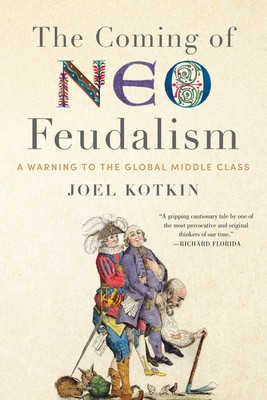
- We will send in 10–14 business days.
- Author: Joel Kotkin
- Publisher: Encounter Books
- Pages: 288
- ISBN-10: 1641770945
- ISBN-13: 9781641770941
- Format: 16.3 x 22.6 x 3.1 cm, kieti viršeliai
- Language: English
- SAVE -10% with code: EXTRA
Reviews
Description
Following a remarkable epoch of greater dispersion of wealth and opportunity, we are inexorably returning towards a more feudal era marked by greater concentration of wealth and property, reduced upward mobility, demographic stagnation, and increased dogmatism. If the last seventy years saw a massive expansion of the middle class, not only in America but in much of the developed world, today that class is declining and a new, more hierarchical society is emerging.
The new class structure resembles that of Medieval times. At the apex of the new order are two classes--a reborn clerical elite, the clerisy, which dominates the upper part of the professional ranks, universities, media and culture, and a new aristocracy led by tech oligarchs with unprecedented wealth and growing control of information. These two classes correspond to the old French First and Second Estates. Below these two classes lies what was once called the Third Estate. This includes the yeomanry, which is made up largely of small businesspeople, minor property owners, skilled workers and private-sector oriented professionals. Ascendant for much of modern history, this class is in decline while those below them, the new Serfs, grow in numbers--a vast, expanding property-less population. The trends are mounting, but we can still reverse them--if people understand what is actually occurring and have the capability to oppose them.EXTRA 10 % discount with code: EXTRA
The promotion ends in 22d.21:50:42
The discount code is valid when purchasing from 10 €. Discounts do not stack.
- Author: Joel Kotkin
- Publisher: Encounter Books
- Pages: 288
- ISBN-10: 1641770945
- ISBN-13: 9781641770941
- Format: 16.3 x 22.6 x 3.1 cm, kieti viršeliai
- Language: English English
Following a remarkable epoch of greater dispersion of wealth and opportunity, we are inexorably returning towards a more feudal era marked by greater concentration of wealth and property, reduced upward mobility, demographic stagnation, and increased dogmatism. If the last seventy years saw a massive expansion of the middle class, not only in America but in much of the developed world, today that class is declining and a new, more hierarchical society is emerging.
The new class structure resembles that of Medieval times. At the apex of the new order are two classes--a reborn clerical elite, the clerisy, which dominates the upper part of the professional ranks, universities, media and culture, and a new aristocracy led by tech oligarchs with unprecedented wealth and growing control of information. These two classes correspond to the old French First and Second Estates. Below these two classes lies what was once called the Third Estate. This includes the yeomanry, which is made up largely of small businesspeople, minor property owners, skilled workers and private-sector oriented professionals. Ascendant for much of modern history, this class is in decline while those below them, the new Serfs, grow in numbers--a vast, expanding property-less population. The trends are mounting, but we can still reverse them--if people understand what is actually occurring and have the capability to oppose them.

Reviews